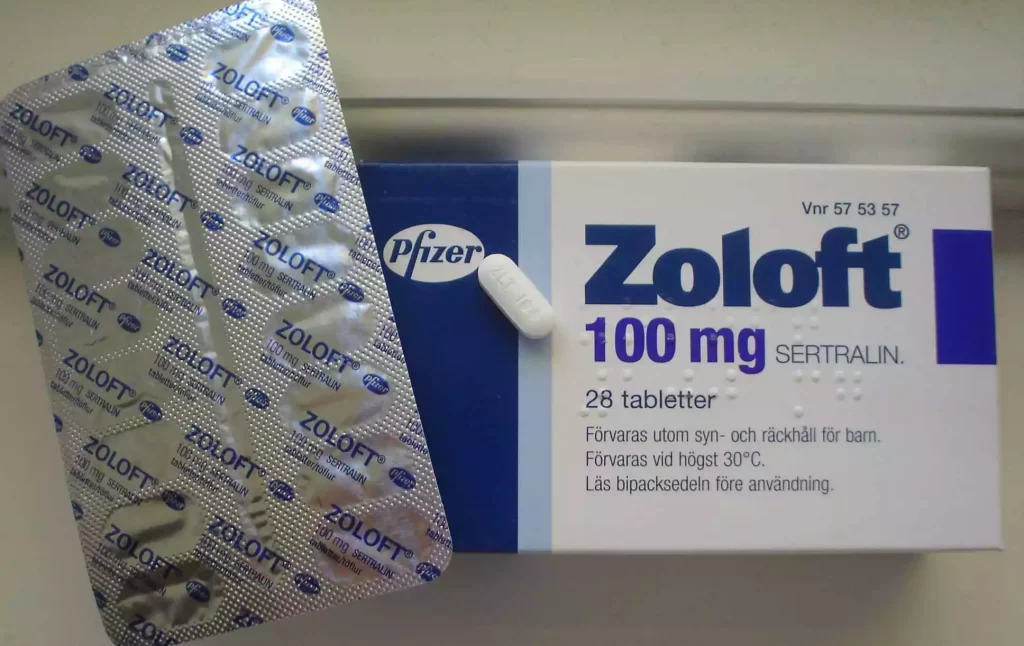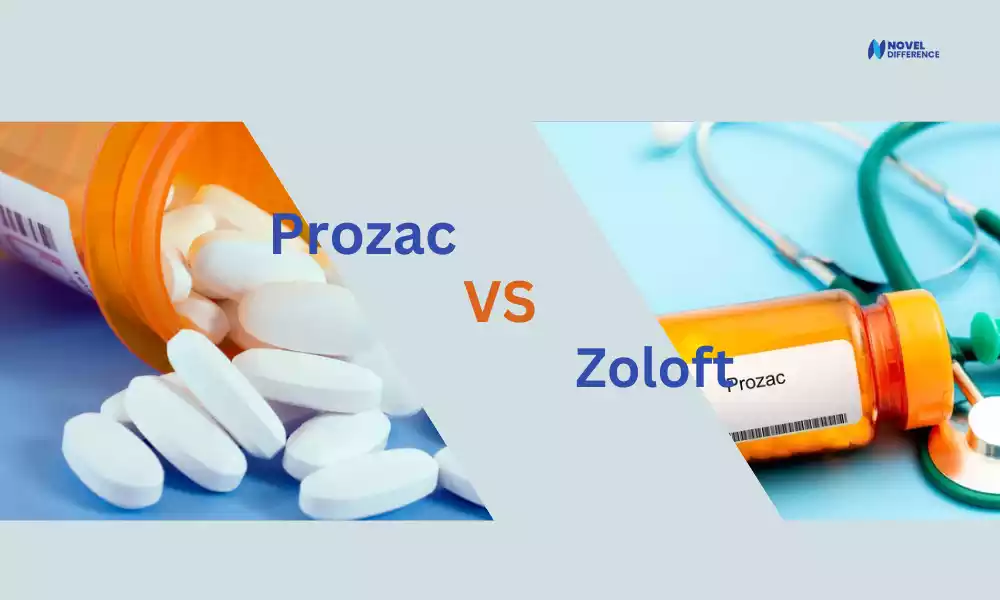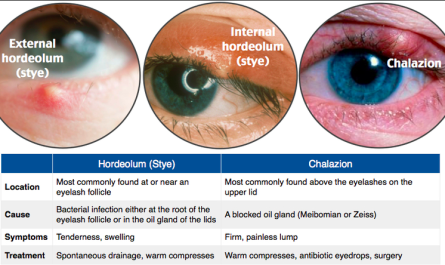Prozac and Zoloft are two widely prescribed medications in the category of antidepressants. While they share similarities as selective serotonin reuptake inhibitors (SSRIs), they also have distinct characteristics that set them apart. Understanding the differences between Prozac and Zoloft is crucial for both healthcare professionals and patients to make informed treatment choices. In this comparison, we’ll explore their mechanisms of action, indications, side effects, and various factors to help navigate the decision-making process.
Overview of Prozac
Prozac, whose generic name is fluoxetine, is a well-known medication classified as a Selective Serotonin Reuptake Inhibitor (SSRI). It is primarily prescribed for the treatment of various mental health conditions, particularly mood disorders.
Here is an overview of key aspects of Prozac:
- Mechanism of Action: Prozac primarily works by increasing the levels of serotonin in the brain. By inhibiting its reuptake, Prozac helps maintain higher serotonin levels in the synapses between nerve cells, which can lead to an improvement in mood and a reduction in symptoms of depression, anxiety, and other related disorders.
- Indications: Prozac is approved by regulatory agencies for the treatment of several conditions, including major depressive disorder (MDD), obsessive-compulsive disorder (OCD), panic disorder, bulimia nervosa, and premenstrual dysphoric disorder (PMD). It may also be prescribed off-label for other conditions, as determined by a healthcare provider.
- Dosage Forms: Prozac is available in various dosage forms, including capsules, tablets, and an oral liquid, providing flexibility for patients with different preferences and needs.
- Dosage Guidelines: The appropriate dosage of Prozac depends on the condition being treated, the patient’s age, and individual response. Treatment often begins with a lower dose and is adjusted by a healthcare provider as needed.
- Side Effects: As with any medication, Prozac can cause side effects. Common side effects include nausea, diarrhea, dry mouth, insomnia, and sexual dysfunction. Patients are encouraged to discuss any side effects with their healthcare provider.
- Efficacy: Clinical studies have demonstrated that Prozac is effective in alleviating symptoms of depression, anxiety, and other mood disorders. Individual responses to the medication may vary, and it may take several weeks for the full therapeutic effect to become evident.
- Drug Interactions: Prozac can interact with other medications, especially those that influence serotonin levels or blood thinners. Patients should inform their healthcare provider about all medications and supplements they are taking to avoid potential interactions.
- Special Considerations: Prozac’s safety and efficacy in special populations, such as pregnant or breastfeeding women and children, should be discussed with a healthcare provider to weigh the benefits and potential risks.
- Discontinuation: Stopping Prozac abruptly can lead to withdrawal symptoms. Patients should follow their healthcare provider’s guidance on tapering off the medication when discontinuation is necessary.
- Patient Education: Patients prescribed Prozac should be educated about its proper use, potential side effects, and the importance of regular follow-up appointments with their healthcare provider to monitor progress and adjust treatment as needed.

Prozac is a widely used SSRI medication with a well-established history of treating various mood and anxiety disorders. Patients should work closely with their healthcare provider to ensure that Prozac is used safely and effectively for their specific condition.
Overview of Zoloft
Zoloft, whose generic name is sertraline, is a widely prescribed medication classified as a Selective Serotonin Reuptake Inhibitor (SSRI). It is primarily used to treat various mental health conditions, primarily those related to mood disorders and anxiety.
Here is an overview of key aspects of Zoloft:
- Mechanism of Action: Zoloft works by increasing the levels of serotonin in the brain. Serotonin is a neurotransmitter associated with mood regulation, and by inhibiting its reuptake, Zoloft helps maintain higher serotonin levels in the synaptic space between neurons, leading to improved mood and reduced symptoms of depression and anxiety.
- Indications: Zoloft is approved by regulatory agencies for the treatment of several conditions, including major depressive disorder (MDD), obsessive-compulsive disorder (OCD), panic disorder, social anxiety disorder, post-traumatic stress disorder (PTSD), and premenstrual dysphoric disorder (PMDD). It may also be prescribed for other off-label uses, as determined by a healthcare provider.
- Dosage Forms: Zoloft is available in various dosage forms, including tablets and oral concentrate (liquid), making it adaptable to different patient needs and preferences.
- Dosage Guidelines: The appropriate dosage of Zoloft varies depending on the condition being treated, the patient’s age, and individual response. Typically, treatment starts with a lower dose, which may be adjusted by a healthcare provider based on the patient’s progress.
- Side Effects: Like all medications, Zoloft may have side effects. Common side effects include nausea, diarrhea, dry mouth, insomnia, and sexual dysfunction. It’s important for patients to discuss any side effects with their healthcare provider.
- Efficacy: Clinical studies have shown Zoloft to be effective in alleviating symptoms of depression, anxiety, and related disorders. Its efficacy varies among individuals, and the full therapeutic effect may take several weeks to manifest.
- Drug Interactions: Zoloft can interact with other medications, particularly those affecting serotonin levels or blood thinners. Patients must inform their healthcare provider of all medications and supplements they are currently taking to avoid potential interactions between medications.
- Special Considerations: Zoloft’s safety and effectiveness in special populations, such as pregnant or breastfeeding women and children, should be discussed with a healthcare provider to weigh the benefits and potential risks.
- Discontinuation: Abruptly stopping Zoloft can lead to withdrawal symptoms. It’s essential to follow a healthcare provider’s guidance on tapering off the medication when discontinuation is necessary.
- Patient Education: Patients prescribed Zoloft should be educated about its proper use, potential side effects, and the importance of regular follow-up appointments with their healthcare provider to monitor progress and adjust treatment as needed.

Zoloft is a widely used SSRI medication with a well-established track record in treating various mood and anxiety disorders. Its effectiveness, dosage, and potential side effects should be discussed thoroughly with a healthcare provider to ensure safe and appropriate treatment.
Prozac and Zoloft comparison chart
Here’s a simplified comparison chart between Prozac (fluoxetine) and Zoloft (sertraline):
| Aspect | Prozac (Fluoxetine) | Zoloft (Sertraline) |
|---|---|---|
| Generic Name | Fluoxetine | Sertraline |
| Class | Selective Serotonin Reuptake Inhibitor (SSRI) | Selective Serotonin Reuptake Inhibitor (SSRI) |
| Mechanism of Action | Inhibits serotonin reuptake, leading to increased serotonin levels in the brain | Inhibits serotonin reuptake, leading to increased serotonin levels in the brain |
| Indications | Major Depressive Disorder (MDD), Obsessive-Compulsive Disorder (OCD), Panic Disorder, Bulimia Nervosa, PMDD | MDD, OCD, Panic Disorder, Social Anxiety Disorder, PTSD, PMDD |
| Dosage Forms | Capsules, tablets, oral liquid | Tablets, oral concentrate (liquid) |
| Dosage Guidelines | Individualized based on condition and patient response | Individualized based on condition and patient response |
| Common Side Effects | Nausea, diarrhea, dry mouth, insomnia, sexual dysfunction | Nausea, diarrhea, dry mouth, insomnia, sexual dysfunction |
| Efficacy | Effective in treating depression, anxiety, and related disorders | Effective in treating depression, anxiety, and related disorders |
| Onset of Action | Several weeks for full therapeutic effect | Several weeks for full therapeutic effect |
| Drug Interactions | Can interact with other medications, particularly those affecting serotonin levels or blood thinners | Can interact with other medications, particularly those affecting serotonin levels or blood thinners |
| Special Considerations | Considerations for special populations (e.g., pregnant/breastfeeding individuals, children) | Considerations for special populations (e.g., pregnant/breastfeeding individuals, children) |
| Discontinuation | Should be tapered off gradually under medical supervision to avoid withdrawal symptoms | Should be tapered off gradually under medical supervision to avoid withdrawal symptoms |
This chart provides a simplified overview. It’s crucial to consult a healthcare professional for accurate and personalized information before making any decisions about medication.
Onset of Action and Time to Therapeutic Effect
Onset of Action and Time to Therapeutic Effect:
- Prozac (Fluoxetine): Prozac typically takes several weeks (usually 4-6 weeks) of consistent use to reach its full therapeutic effect. Patients may not experience immediate relief from symptoms after starting the medication.
- Zoloft (Sertraline): Zoloft has a similar onset of action to Prozac, often taking several weeks (4-6 weeks) to achieve its maximum therapeutic benefit. It also requires patience before symptom improvement becomes noticeable.
Both medications require time for the brain’s neurotransmitter levels to adjust, which is why consistent and long-term use under the guidance of a healthcare provider is essential for their effectiveness. Patients should be informed of this delay in onset when starting treatment.
Special Populations
Both Prozac and Zoloft require careful consideration in specific patient populations:
- Pregnant and Breastfeeding Women:
- Prozac: May be used cautiously during pregnancy, with the potential for risk assessment by healthcare providers.
- Zoloft: Generally considered a safer choice during pregnancy and breastfeeding, but risks and benefits should be discussed.
- Children and Adolescents:
- Prozac: Approved for use in children and adolescents with specific indications like MDD and OCD.
- Zoloft: Approved for use in children and adolescents with various indications, including OCD, social anxiety disorder, and PTSD.
- Elderly Individuals:
- Both medications may require dosage adjustments in older adults due to potential differences in metabolism and increased sensitivity to side effects.
- Individuals with Comorbid Medical Conditions:
- For patients with other medical conditions, such as liver or kidney disease, dosages may need adjustment, and potential drug interactions should be carefully considered.
Discontinuation and Withdrawal
Discontinuing Prozac and Zoloft should be done under medical supervision to minimize withdrawal symptoms:
- Prozac (Fluoxetine): Gradual tapering is recommended to prevent discontinuation syndrome, which may include flu-like symptoms, mood changes, and dizziness. Tapering should be overseen by a healthcare provider.
- Zoloft (Sertraline): Similar to Prozac, Zoloft should be tapered gradually under medical guidance to reduce the risk of withdrawal symptoms, such as dizziness, fatigue, and mood swings.
Abruptly stopping these medications can lead to uncomfortable withdrawal effects, so patients should not make dosage changes without consulting their healthcare provider.
Patient Considerations
When choosing between Prozac and Zoloft, patients should:
- Consult a Healthcare Provider: Seek guidance from a healthcare professional who can assess individual needs and recommend the most suitable medication based on the patient’s condition and medical history.
- Consider Indications: Evaluate which medication aligns with the specific mental health condition being treated, as both Prozac and Zoloft have approved uses for different disorders.
- Account for Side Effects: Discuss potential side effects and their impact on daily life and well-being. Choose the medication with side effects that are more manageable for the individual.
- Monitor Efficacy: Be patient, as both medications take several weeks to show full effects. Regular follow-ups with a healthcare provider are crucial to assess progress and make any necessary adjustments.
- Review Cost and Accessibility: Consider the cost, insurance coverage, and availability of each medication to ensure affordability and accessibility.
- Understand Individual Response: Recognize that individual responses to medications can vary, so what works best for one person may not be the same for another. Patience and open communication with healthcare providers are key.
Ultimately, the decision between Prozac and Zoloft should be made collaboratively between the patient and their healthcare provider, taking into account these considerations and individual circumstances.
Conclusion
Choosing between Prozac and Zoloft depends on various factors, including the specific condition, individual response, and healthcare provider guidance. Both medications are effective for treating mood and anxiety disorders, but their differences in indications, side effects, and patient considerations require careful consideration. It’s essential for patients to work closely with their healthcare providers to make informed decisions and achieve the best possible mental health outcomes.




